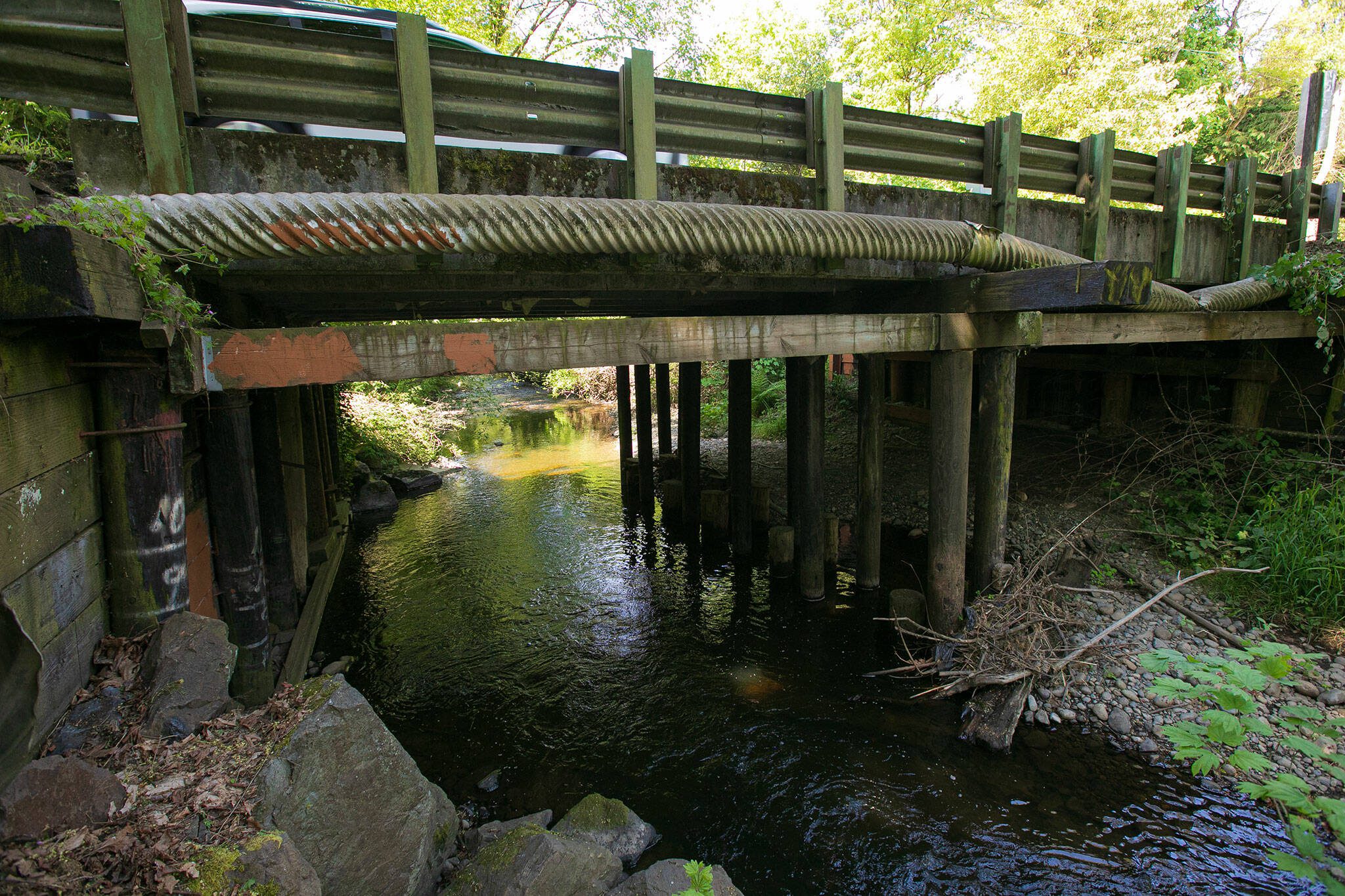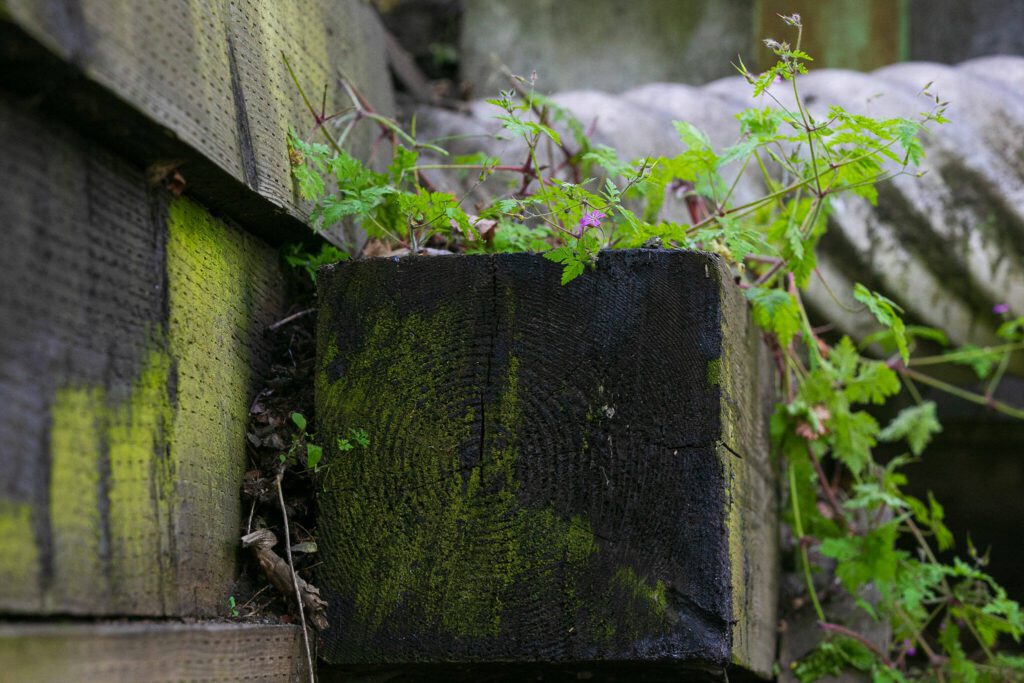BOTHELL — The timber bridges dotting Snohomish County are disappearing.
A throwback to a once-thriving industry, wooden bridges used plentiful local lumber. As the years passed, concrete and asphalt became the name of the game.
One timber bridge, near Bothell, is nearing the end of its life.
Built in 1960, the soon-to-be replaced Swamp Creek Bridge 503 is one of 67 bridges in Snohomish County either partly or fully constructed with timber. Many of them have rot in their supports. The county inspects and maintains 210 total bridges throughout the county.
Like many built with wood in the 20th century, Bridge 503 is falling apart — and needs to be replaced. Locust Way runs atop the bridge. It’s a main thoroughfare where Bothell and Brier city limits abut unincorporated Snohomish County.
Driving over Swamp Creek, the need for repair work might not be obvious. But take a look underneath.
Wooden beams sunk into the creek are old and worn. Water has eaten away at the shoreline and threatened the bridge’s supports in the past. In fact, last year, the county added rocks and material near the bridge to help stop erosion. Erosion, or more specifically, scouring, is the leading cause of bridge failure, county Bridge Engineer Tim Tipton said on a recent walking tour.
“Those take more maintenance, so we are fully transitioning out of that right now,” Tipton said. “A lot of the (timber) bridges that we are seeing are very similar to this site and nearing the end of their life.”
Next year, those timbers are coming down — along with the layers of asphalt and concrete on top of them. The bridge along Locust Way scored a 16 out of 100 on the federally standardized bridge scoring system. That’s about as bad as it sounds: Zero is a bridge in the water.
Despite the bridge’s poor rating, it’s not going to fall down at any moment, Public Works Director Kelly Snyder said as she stood near the bridge.
“We would close it,” Snyder said, pointing to a recent example when the county did just that for Riley Slough Bridge 52 on Tualco Loop Road south of Monroe last fall.
It was a much-needed closure as water can flood the north end of Tualco Loop Road, cutting off residents, Public Works spokesperson Julie Kuntz said.
County workers identified the structural issue on a routine inspection and proceeded to permit, plan and repair the bridge within two weeks.
Most bridges in Snohomish County are in passable shape, according to the recently released 2023 bridge report — which may or may not be reassuring. Five bridges scored under 40 on the federal scale and 97 bridges scored 80 or above. Those on the lower end get priority, like Swamp Creek 503, making them better candidates for more state and federal money.
“I think the county has done an amazing job trying to keep all its bridges in good operating order,” Snyder said. “But there’s not enough money on the planet for all infrastructure for all jurisdictions to be replaced.”
Tipton and his staff of two full-timers (plus two other fill-in staffers) inspect all the bridges in Snohomish County. Every bridge is inspected at least once every two years, with some bridges inspected yearly.
So what’s an inspection like?
Inspectors literally knock on the wood. And concrete, too. If it doesn’t sound right, they have a variety of tools to inspect it. In wood, for example, they use a “really thin needle” to check for rot.
“It’s a really cool tool,” Tipton said.
Inspections inform the bridge’s weight capacity.
Public Works also publishes an annual bridge report, which has pretty much everything you’d need to know about Snohomish County bridges. It has a map of where they’re all located, where bridges rank on the federal scale and upcoming projects.
Snohomish County has replaced 56 bridges since 2003 and has plans to rehabilitate or replace nine more in the next five years.
For Swamp Creek Bridge 503, detours will span over 4 miles for months. The project will cost about $4.5 million, with much of the money coming from federal funds.
On the current bridge deck, there is no safe way to walk across. The new bridge will be longer and wider, with a sidewalk. Beams will no longer be sunk sunk into the middle of the creek as the new design does not require supports in the middle.
About a quarter-mile away, Swamp Creek Bridge 504 was replaced in 2016. The differences are stark.
It’s much easier to get underneath the newer bridge, for starters. This is a benefit to bridge inspectors in particular.
The bridge is designed to be Earth-friendly as well. Water from the bridge, which can contain salmon-killing tire dust, is filtered through a process that mimics nature. County crews build a catch pond and cover it with a very specific mixture of soil. The water is filtered before it reenters the groundwater table.
At Swamp Creek Bridge 504, it appears to be working. The scene underneath the bridge is serene, as birds chirp and water trickles, unfettered by modern construction. What appears to be the remnants of a beaver dam sit nearby: The original bridge-builders have timeless architecture.
The catch pond requires some maintenance, Tipton said, but it’s a far better solution than polluted water going straight into a stream. And it’s clear that with a little foresight, a new bridge can be a benefit for more than just cars.
“Even though we’re coming in, building a bridge and we’re and we’re cutting down trees, the overall net benefit is going to be better for the environment,” Tipton said. “Because we’re treating all the water now. The water that before was just flowing into the creek and now we’re treating it.”
Jordan Hansen: 425-339-3046; jordan.hansen@heraldnet.com; Twitter: @jordyhansen.
Talk to us
> Give us your news tips.
> Send us a letter to the editor.
> More Herald contact information.































